Team of Teams / When Agile Methodologies Fall Short
In a rapidly changing and uncertain world, the intellectual potential of employees is the greatest capital a company can have. How to build teams and manage that capital mindful of the various and rapidly evolving customer needs? And how should a company that has defined itself as the Digital Transformation Partner implement its vision?
We have answered these questions by introducing a new business strategy and implementing the Team of Teams approach.
Why We Wanted to Change
We’ve been implementing solutions for the digital transformation of commerce for 25 years now. Most of our projects require an appropriate combination of business, technological and communication expertise.
Flexibility and the ability to respond to clients’ current needs are of paramount importance for us. We also wanted our clients to feel that when working with several teams, they work with one competent technology partner. A few years back, we decided to transform ourselves into agile teams that have common goals and are ready to make quick decisions based on the knowledge of people who are knowledgeable in their fields – based on their actual roles rather than on what’s written on their business cards.
We were looking for inspiration and different ways to achieve our strategic goals.
What other factors did we have to consider on the way to transforming Univio?
Organizational Culture
For many years, our focus has been on agile people and team attitudes, a flat organizational structure, meritocracy and partner democracy. The legacy model with “commanders” in charge who have only limited knowledge and make misguided decisions gets replaced with democratized, competent teams that put a high premium on values, collaboration and common goals.
Strategy and Technology
Univio concentrates on the digital transformation of commerce by selecting the most appropriate technologies and solutions tailored to the needs of each client. To make this happen, our business model had to be flexible enough. We do not have any single, ready-made proposal for a final product. We listen to the client and pick optimal sets of solutions and skills.
Customer Needs and Technology
We’re a technology company, but clients buy our services to meet their business needs and goals. As an end-to-end digital transformation partner, we often guide our clients through the complex process of changing the company’s strategy and operations. This entails deploying new or upgrading existing technologies to ensure processes are optimized and the organisation is efficient and keeps abreast with the modern world.
For this reason, we had to ditch the previous model of technological silos and look holistically at clients’ core needs.
Looking for Inspiration / What Business Management Models We Have Considered
We were determined to do our internal transformation wisely. We were wondering which methodology to use to build an organization that can flexibly adapt to various situations.
We took into account hybrid structures, holacracy and sociocracy, with third-party consultants guiding us through the process. We liked many elements of various work organization methodologies, but none of them was, in our opinion, fit for purpose in the context of our vision, experience and position.
For this reason, we decided to develop a solution that would best work for us and would effectively support us in serving our clients’ needs. We wanted to use our existing knowledge and experience to build a solution that would combine our corporate culture (the “WHY”) and strategy (the “WHAT”), offering an effective way of fulfilling our vision (the “HOW”).

We were particularly inspired by the Team of Teams approach.
What Is Team of Teams?
Team of Teams is an approach to building a structure based on a constellation of smaller teams that work together closely. This concept was made popular by retired US Army General Stanley McChrystal in his book “Team of Teams: New Rules of Engagement for a Complex World”.
In the Team of Teams approach, it’s not enough to put people in one room and say: “You’re a team now!”. One of the key things is to ensure that everyone understands what is happening in the organization. Access to information means minimizing the risk that, for example, two teams will do the same job working on a similar project.
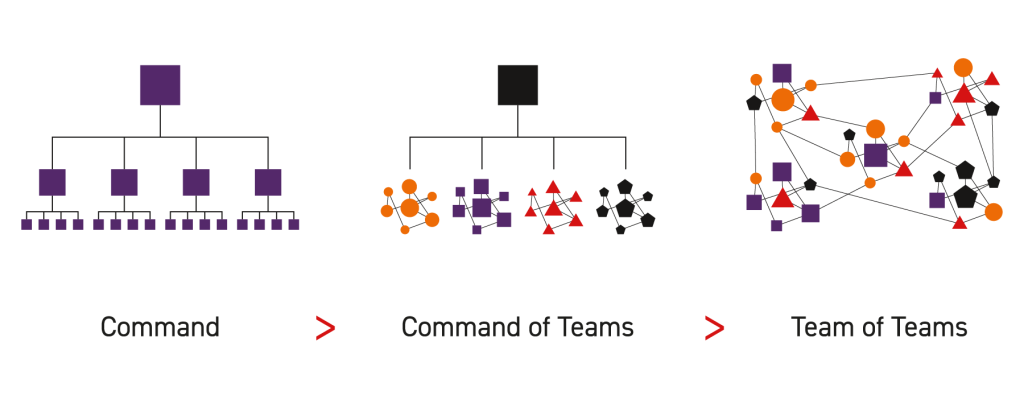
How Did We Adapt the Team of Teams Model to the Needs of Univio?
Team of Teams is more of a philosophy rather than a rigid model, so it should be given a wide interpretation. We knew that we wanted to work on a cross-team, multidimensional and multidisciplinary basis. Agility and flexibility were also important to us. And all this was supposed to help us deliver the highest quality projects to our clients.
When building Team of Teams, we sought to create a network of agile and competent teams that could flexibly adapt to prevailing circumstances. We did not want to be a rigid structure in which implementing any change required raising a massive project, then capturing lessons learned and finally … playing the blame game.
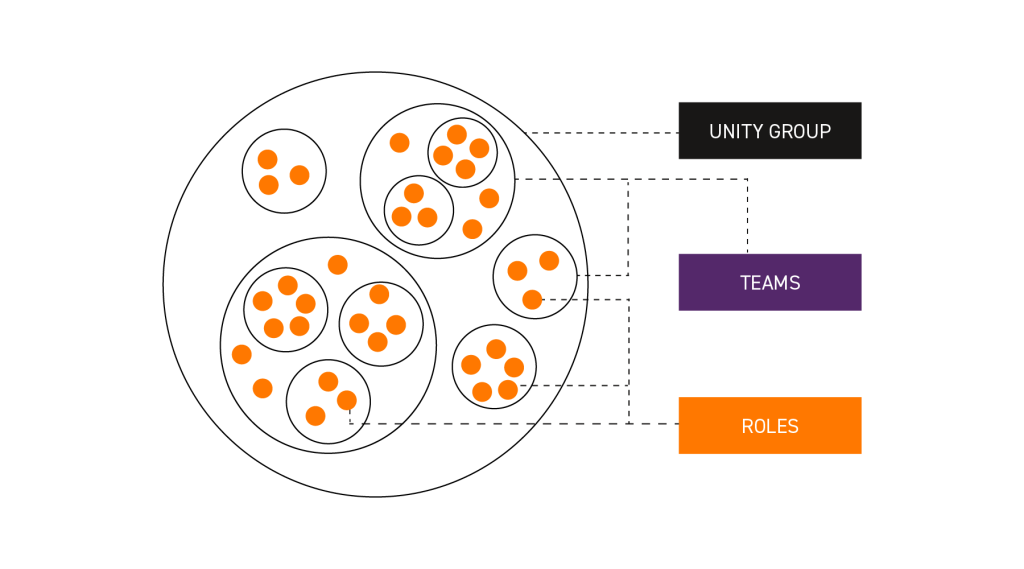
So how does our structure work in practice?
Team of Teams in Practice
In our adaptation of Team of Teams, we focused on forming agile teams working based on their own contracts and goals in support of the company’s main goals. Employees play various roles in this setup.
Roles over Positions
The team consists of people who have roles needed by the company – not position holders. The key thing is expertise – which emanates from skill and experience rather than from a job position. Moreover, thanks to Team of Teams, we work in various projects and teams, which gives us the opportunity to operate in various environments and gain new experiences right from the start. We continue to use job titles, though, but usually for the purpose of external communication. On a daily basis, we tend to rely on roles.
If someone works in one team but wants to try their hand, for example, as a scrum master, they can temporarily take up the new role. In this way, without taking much risk, after testing the new ground, they can choose to back out or go down the newly chosen path.
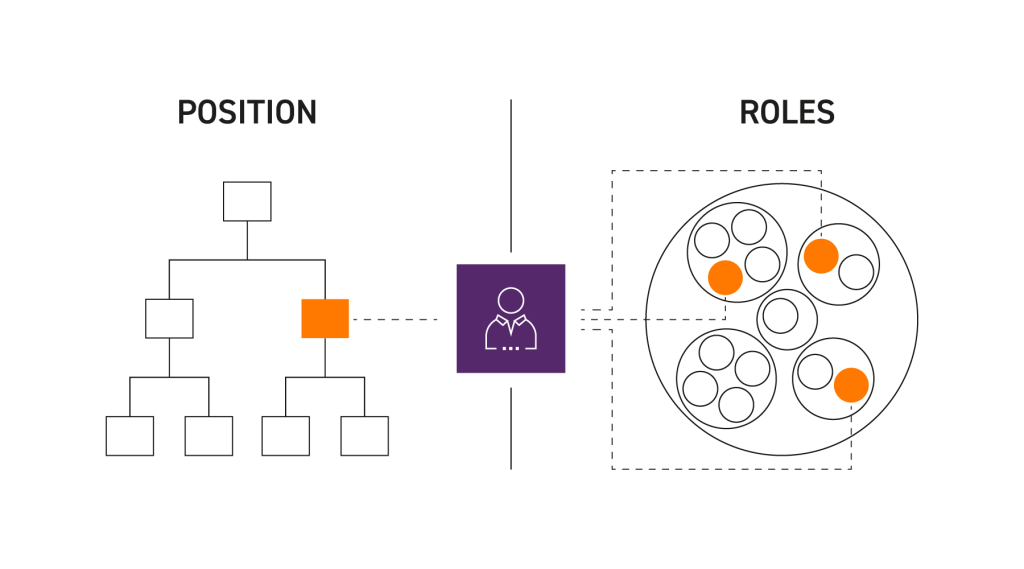
Positions do not offer such flexibility and require specific career paths. They also need to be filled when their holder takes up a different position. Roles, in turn, build professional bridges. If someone feels the need for a change, they can join a different team or project and then return to their original place having gained new experience in the meantime.
How Do We Support Collaboration Between Teams?
Building a culture of good cooperation between teams is one of the key success factors in the Team of Teams philosophy. This is why we have created roles in our teams that help us reach our goals. At the level of the whole organization, we have several tens of well-described roles. From the point of view of the ability to cooperate between teams, we have roles such as:
Leader
Each team has its own leader who is responsible for the business aspect. He/she sets priorities, defines further roles within the team and helps in removing work obstacles. Leaders have a few traditional duties, such as setting the budget, but above all they give shape to the team’s work culture.
Head
This role belongs to the people who own or otherwise strongly influence a particular process. They often work between teams. People in the Head role have a high degree of independence and freedom to take decisions provided that they are consistent with the company’s goals.
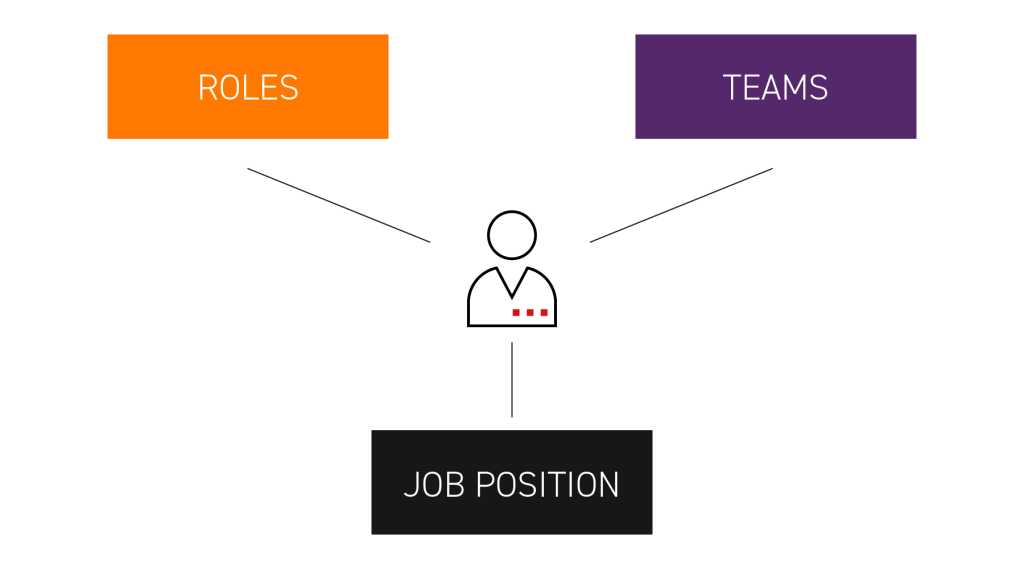
Other roles
It is not uncommon for people to have more than one role. Someone may be a Leader in one area, a Head in another, and be involved in yet another team.
We use roles to clearly define everyone’s degree of involvement. As the company grew, it became increasingly difficult for us to tag a person with a single, limiting job title. Roles allowed us to change that.
Keeping track of changes in roles in teams is highly important from a practical perspective. Holaspirit is a tool that illustrates the structure and model of collaboration between teams, and can be used for describing roles. It also helps quickly check who has what roles in what teams.
Distributed Decision-Making Focused on Common and Known Goals
We distributed the decision-making process as we trust our people. As Steve Jobs said: “It doesn’t make sense to hire smart people and then tell them what to do. We hire smart people so they can tell us what to do.”
Following on from this, we empower our people so that they can have a real impact on what happens in the company and in the projects they are involved in. This is what they do – not any executive board or other supporting “structures”. At Univio, we assume that we work with experts who know their stuff, and so others can trust them.
However, influence also entails responsibility.
We have long noticed that, from a psychological perspective, putting responsibility in the hands of a team strengthens engagement and brings a lot of satisfaction. In our company, no one acts like a chief just because they are a Head.
Understandably, bosses are responsible for achieving business goals, but we do not need any additional hierarchical structure or corporate decision-making process for our projects to be implemented effectively.
What Does Team of Teams Mean for Employees?
In addition to trying their hand at a different role, testing an alternative path or understanding company goals, employees can benefit from Team of Teams in many other ways.
Any unwanted behaviors are eliminated by teams themselves. Moreover, each team develops a contract that it agrees to comply with. For example, this approach was seriously applied at the beginning of the pandemic, when each team independently decided to switch to remote working. The team also has its say in recruitment, especially for leadership positions.
It’s easier for our people to cooperate and join client teams for some time. They are able to deal with each client flexibly and work together on the project.
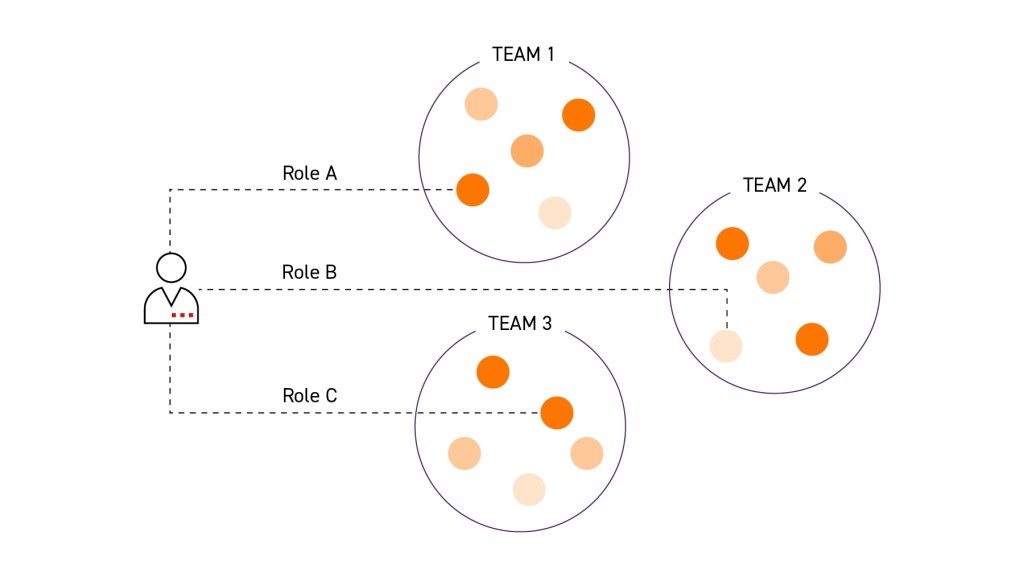
Team of Teams Benefits for Clients
Our clients gain the opportunity to work with cross-functional teams that cater to their specific needs. At the same time, they feel that these people understand each other well and follow a common methodology or framework. The concept of agile teams of experts grouped around a project ensures from the very start that in each case we will pick from our toolbox the solutions that will respond to the client’s needs, and that those solutions will be applied by the best specialists in their respective areas.
We don’t sell “off-the-peg” products or technological silos. As a digital transformation partner, we advise and guide companies through the process of transitioning to e-commerce. If someone wants to improve only a small part of their business, we will respond flexibly.
We build customized solutions, ensure agility and quick decision-making, providing clients with end-to-end service. To enhance cooperation between clients and Univio experts, we have introduced the role of Portfolio Managers. When several teams work for the same client, the Portfolio Manager is the point of contact for all the teams dealing with the client.
Team of Teams / Is It for You?
When we started the process of planning change at the company, we spent a lot of time thinking what would work best for us and offer the best growth opportunities. We chose Team of Teams because this approach was closest to our business needs, organizational culture and development ambitions. It also helped us put a structure around our relationship with clients.
However, this decision depended on many factors, including the nature of the industry, the high independence of teams, skills of our specialists, maturity of our management team and the direction of changes. Importantly, we are not fond of micromanagement, so empowering teams came naturally for us, and we had been testing it for a long time.
Is Team of Teams the right solution for your business?
Honestly, I don’t know. When looking for your own solution, you should definitely:
- Be aware of the actual organizational culture of your company;
- Have a clear business strategy in place;
- Boldly look for your own way and your own solution;
- Be consistent!
I trust that our management model will inspire you to take a closer look at your own organization. Perhaps a change will allow your company to operate even better, taking into account the needs of employees and clients.
At Univio, we see that Team of Teams actually works. It allows us to pursue our goals and earn positive employee feedback. As a testament to this, we were recognized as a Great Place to Work for another year in a row and – despite one global crisis after another – our financial performance has remained stable and satisfactory.
Get inspired:
- Agile Organizations podcast, 600 people and not a single director (600 osób i ani jednego dyrektora), an interview with Grzegorz Kuczyński
- General Stanley McChrystal, Team of Teams: New Rules of Engagement for a Complex World.
- Frederic Laloux, Reinventing Organizations.
- Joost Minnaar, Pim De Morree, Corporate Rebels
- Paul Leonardi, Tsedal Neeley, The Digital Mind
- Paweł Motyl, Schrodinger’s World. A Chronicle of an Unpredictable Future
- Podcast on culture and responsibility, Team of teams management
- Blog Corporate Rebels







